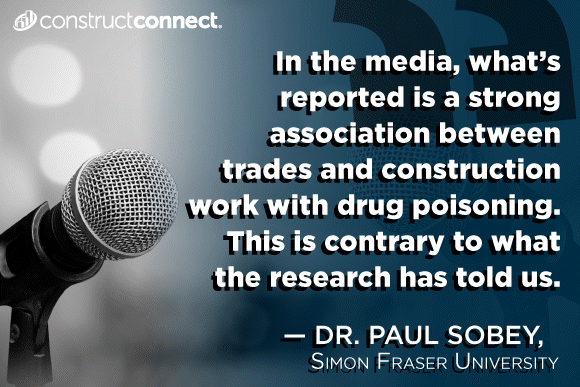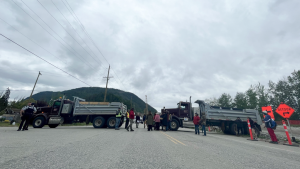The executive director of British Columbia’s Building Trades (BCBT) has expressed worry that a new report on substance use in the construction industry could decrease supports for workers.
“The construction industry should not use this study to divert treatment and harm reduction resources from the sector,” said Brynn Bourke in a statement.
The organization said an initial review of the British Columbia Construction Safety Alliance (BCCSA) sponsored study, Construction Safety and Substance Use: Blueprint for Action, has raised “several concerns.”
“The findings in the (report) contradict our experience in the construction industry,” said Bourke.
During an event presenting the study on March 7, authors of the report noted most opioid deaths occur in the unemployed population of B.C.
“Prioritizing distribution of opioid medications, Narcan kits to construction sites and other harm reduction initiatives is not going to prevent the vast number of deaths occurring in unemployed people, not employed people,” said Dr. Paul Sobey.
But the BCBT says naloxone and Narcan kits have been instrumental in saving lives.
“Our experience is that naloxone is saving lives and training along with access should be increased. The use of naloxone and naloxone training creates a space for destigmatizing the conversation around drug use,” Bourke said.

The report emphasized the fact that cannabis and alcohol are far more prevalent substances within the sector, with more than 80 per cent of individuals surveyed for the report saying they drink.
The report states, “the blueprint project found that cannabis and alcohol account for the vast majority of safety and health-related risks faced by workers in the B.C. construction sector.
“Substantial overlap between poisonings and construction appears to be a disservice to the vast majority of those who are at risk of poisoning, and diverts attention from more robustly demonstrated safety and health-related risks in the construction sector,” it reads.
Bourke said the Construction Industry Rehabilitation Plan (CIRP) serves roughly 220 construction workers per year, helping them deal with substance use issues. She said the CIRP intake has increased by 64 per cent since the pandemic began.
“We are aware that the majority of members seeking addiction support services are seeking supports for alcohol, cocaine and marijuana. This does not mean that our members are free from the dangers of B.C.’s poisoned drug supply,” she said.
“The toxic drugs crisis is disproportionately harming construction workers.
“It doesn’t matter if we’re talking about opioids, cocaine, or any other substance. If people are using drugs, whether during downtime or on the job, there’s a good chance they contain fentanyl or fentanyl analogues. And that means those drugs can kill them.”
Dr. David Baspaly is the president of the Council of Construction Associations (COCA) and chair of the organization’s Opioid Taskforce. He said the report is useful as it shines light on the state of substance use in the industry and can help ensure resources are focused on the right problems.
He said COCA will be moving forward with its opioid reduction initiatives in the sector.
“We won’t put the brakes on. In fact, we’re going the other way,” Baspaly said.
He emphasized more data is always welcome when dealing with serious issues like substance use and that naloxone kits will continue to be a priority in fighting the toxic drug supply.
“Our philosophy is we get a kit in every hand, to all of the companies and all the workforce out there. That’s our goal, and to get the education resources out there,” he said.
He said the trade off to trying harm reduction techniques is worth the financial risk.
“If we’re wrong, we spent a little bit more money than we should have. If we’re right, we save some lives.”
Baspaly said he didn’t perceive the report as trying to curb harm reduction initiatives in the sector.
“The report paints a picture that we’ve got alcohol abuse, we’ve got people dabbling in different medications and obviously marijuana,” he said.
The B.C. Coroners Service Death Review Panel: A Review of Illicit Drug Toxicity Deaths studied roughly 6,000 toxic drug deaths between August 1, 2017 and July 31, 2021 in B.C.
The review states 35 per cent of the deceased were employed when they died and more than half of them worked in trades, transport or as equipment operators.
Baspaly said the BCCSA report highlights the construction sector is extremely safety minded and that huge strides have been made in the past decade to dealing with substance use and health in the industry.
“It’s a nice message in the report that says a lot of the people recognize the culture of safety in the industry,” he said.
All in, he said the report is a “fair representation of the demographic and I think is a fairly good gauge of where things are at right now.”
But Bourke wanted to ensure the report does not chip away at the foundations of harm reduction.
“Support for addiction and mental health services should be drastically increased. This industry must accept the reality that poisoned drugs are killing construction workers,” Bourke said.











Recent Comments